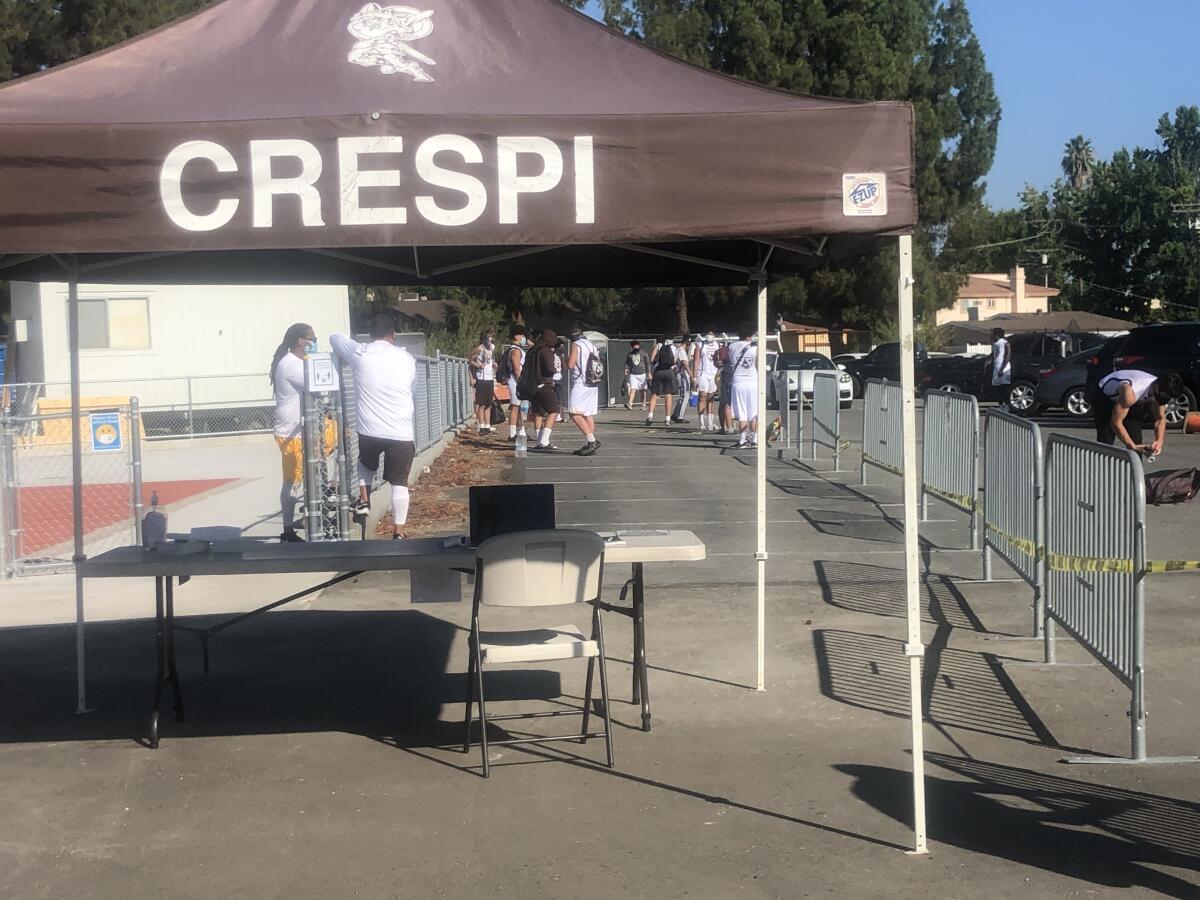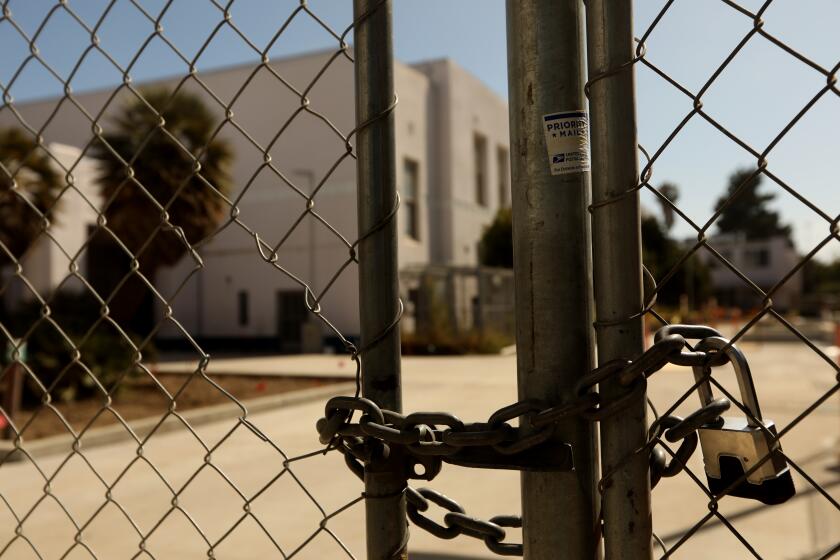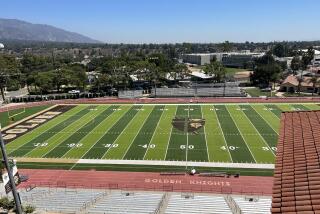If there is high school sports overlap, tough choices await athletes

When two Encino Crespi High wide receivers mingled a little too closely during a water break at a morning workout, the school’s athletic trainer made sure they kept their distance.
“Gentlemen! Six feet, please,” she said. “And make sure you keep your mask on. Unless you are drinking water, I don’t want to see your face.”
The players quickly corrected themselves. Then they jogged back to the field, where coach Dameon Porter was waiting. The next drill focused their releases off the line of scrimmage against press coverage, with cones representing defensive backs.
The sun was out, though earlier in the morning the sky had been filled by gray clouds that formed a metaphor for the fall high school sports season. It looked pretty murky.
On Monday, the California Interscholastic Federation is expected to announce all high school sports competition in the state will be delayed until at least January amid the COVID-19 pandemic. A resurgence of cases in recent weeks prompted Gov. Newsom to reimpose tight restrictions to certain businesses and activities. The Los Angeles Unified School District also announced a plan for students to resume learning remotely when school starts next month, further complicating efforts to play sports in the fall.
This postponement seeks to mitigate the health-related issues resulting from the viral outbreak. But the temporary solution also creates questions. How will teams use that extra time to prepare? Will the fall and winter sports seasons overlap more than usual? What happens to multi-sport athletes? How will incoming freshmen adapt?
Coaches and players say they don’t have all the answers.
“For us at Crespi, we don’t care when football season is, we just want to know when it is so we can get ready,” Porter said. “I’ve taken the approach of not worrying about what we can’t control and worry about what we can.”
Porter said 15 of the 82 players on his roster are incoming freshmen, and he trusts his upperclassmen to lead the newcomers.
After schools shut down in March, returning players continued strength and conditioning training through video conference calls. With freshmen coming into a new environment, Porter thinks a delayed season actually benefits them.
“If you’re a freshman and you’ve never played football before, well, guess what, you get six months of strength and conditioning before you play high school football,” Porter said. “… You get to settle in academically and you get to be with the team. Normally you don’t get that; usually it’s such a quick turnaround.”
The CIF is expected to postpone the fall sports season until January 2021, creating a new set of problems for high school athletes this fall and next year.
Alex Leinbach, a 15-year-old freshman, has never played football and is interested in becoming a wide receiver. He said he’s antsy about making more friends, and because of the practice structure, he has yet to meet much of the team.
He said he’s enjoyed learning a new sport, but his favorite is basketball. If the fall and winter sports season overlap because of the delay, he would choose the hardwood over the gridiron.
“I’ve been playing basketball for basically my whole life, and I feel like I’m better at that,” Leinbach said. “If it came to it, I would choose that.”
Porter said he’d support any athlete in that situation. But he thinks the schedule wouldn’t force players to make such a decision. The seasons typically overlap only for a few weeks if the football team reaches the playoffs.
If the fall season is pushed back, Porter believes the other seasons will be delayed too. If for some reason they aren’t, Anthony Jefferson, coach at Los Angeles Cathedral High, said he’d work with coaches of different sports to ensure the athlete is able to play two sports at once.
“The most important thing is that our players have success in both sports,” Jefferson said. “So our job is to manage his minutes and how much he played so he’s fresh on both ends and he can be successful and not get hurt.”
Kami Miner, a Redondo Union senior who last month committed to play volleyball at Stanford, the reigning national champion, is faced with a different dilemma. It’s not what sport she’ll play, but whether she’d play for the Sea Hawks or her club team.
If the high school season is pushed back, it will almost certainly coincide with the club volleyball season. Club volleyball usually presents higher competition, and most college coaches scout those tournaments.

At this time, Miner said she doesn’t know what choice she’d make, though she said she is leaning to challenge herself and honor both obligations, which might require a special waiver since the CIF does not allow athletes to compete simultaneously in both. She’s spent the extra time with family and has trained on the sand in Redondo and Hermosa Beach. She said she feels ready, but would make the decision when she needs to.
“It would definitely be a busy spring,” she said with a chuckle. “I love the sport so much that I know I’ll want to do both, but we’ll see.”
Tommy Chaffins, volleyball coach for Redondo Union, said he understands some of his athletes might never have had to make a choice like that. But regardless, whether they play for him or for their club, he said he’d support them.
“They have to make the best decision for themselves,” Chaffins said. “If they feel playing for their club will give them the most exposure to get a college scholarship, I would be behind them 100%.”
Another issue includes scheduling. Pushing the season to January presents two options: Will the next season start in January 2022, or do you crunch two seasons into 2021 with a traditional fall start to football and volleyball?
AJ Duffy, a junior quarterback at Moreno Valley Rancho Verde who has offers from Oregon and USC, said he would be happy with either. He thinks people will adjust accordingly if they play two seasons in one calendar year.
“We’d have to be a little more cautious,” Duffy said. “We’d probably do a little less hitting in practice. I think we’d be good, though. It would just be different with less of an offseason.”
With all of the circumstances, Chaffins takes comfort in one thing: Sooner or later, high school sports will be back. When they come back, when all of the logistics and protocols are in place, he thinks it will be a special moment.
“I think it will be emotional for the kids, the coaches and the community,” he said. “I think it will be a really big step in the healing process. And I think it will help unite us too.”
More to Read
Get our high school sports newsletter
Prep Rally is devoted to the SoCal high school sports experience, bringing you scores, stories and a behind-the-scenes look at what makes prep sports so popular.
You may occasionally receive promotional content from the Los Angeles Times.








